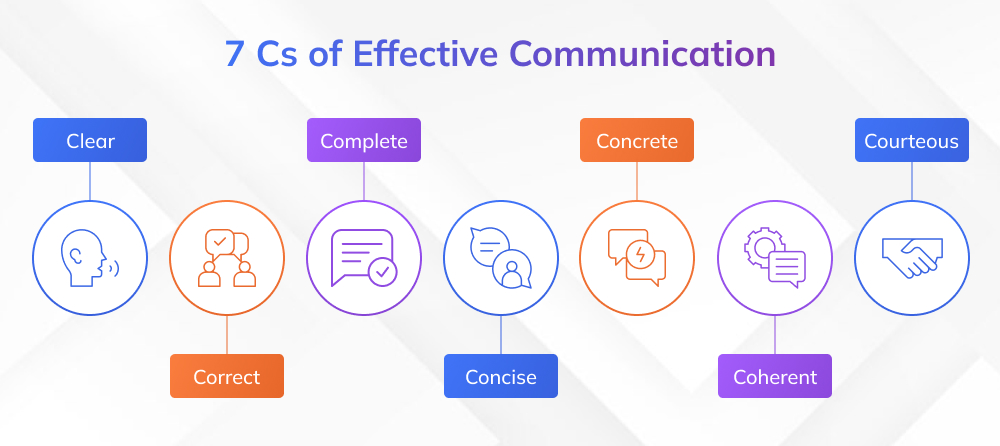
What are the 7 Cs of communication, and why are they important in the workplace?
Employees today spend endless hours on emails, meetings, presentations, and reports. Yet much of that effort is wasted because the messages are unclear, concise, or unactionable. That’s where the 7 Cs of communication come in.
A study conducted by the McKinsey Global Institute and International Data Corporation reveals that employees spend nearly 30% of their time on email. Add to that the hours in conference calls, presentations, and report writing, and the cost of poor communication becomes even clearer. Without a structured approach, miscommunication drains productivity and slows decision-making.
In this blog, we’ll explain the 7 Cs of communication with examples, show how small changes transform a “bad” message into a “good” one, and give you simple practice exercises with answers you can even use as an assignment for your team. By the end, you’ll know exactly how to apply the framework to cut misunderstandings, speed up responses, and strengthen workplace relationships.
7 Cs of Effective Communication
The 7 Cs of effective communication form a practical checklist that helps professionals ensure their messages are understood the first time. Instead of being a theoretical model, the 7 Cs are skills you can practice daily, whether writing emails, preparing presentations, or leading meetings.
In this section, we will explain the 7 Cs of communication, provide examples, highlight common mistakes, and offer simple exercises with answers. Each “C” builds on the others, giving you a complete framework to communicate with clarity, confidence, and impact.
1. Clear
Clear communication means your message is easy to understand on the first read, without the recipient having to guess, clarify, or come back with follow-up questions. Lack of clarity usually creates delays, confusion, and wasted time. As an example of poor communication skills, consider the email below.
❌ Bad Example (Unclear Email)Dear James, I would like to talk to you about the new client’s project, which the engineering team discussed yesterday. I might need the help of John from your team. Regards, Why it fails:
✅ Good Example (Clear Email)Dear James, As you may know, we have signed up XYZ as our new client. I had a meeting with the engineering team yesterday and discussed the campaign requirements for this project. John Redden from your team did a pretty good job last time doing the social media campaign for ABC, and so I would like him to work on the XYZ campaign too. Would you be available sometime tomorrow to discuss this further? Regards Why it works:
|
2. Correct
When too many emails are being written in a day, people tend to type fast and, therefore, might make spelling mistakes. Spell check will not be able to catch it if the wrongly spelled word is in fact another word in the English language.
You also must ensure that you address people correctly and spell their names correctly. Additionally, you must ensure that the reader has sufficient knowledge and education to understand the technical terms you use in your communication.
Mini Case Study: The Cost of a Typo
A mid-level manager once sent a proposal to a client referring to their company as “GlobalSoftware” instead of “GlobalSoftware.” The typo went unnoticed until the client brought it to our attention in the review meeting. While minor, it left the impression of rushed work and a lack of attention to detail. The deal eventually went to a competitor who presented a flawless proposal.
❌ Bad Example EmailSubject: Project plan update Dear David, Further to our conversation today, I am attaching the plan for the first stage of the project. Hope the one weak deadline is okay with you and your team. Regards, Sally Issues:
✅ Good Example EmailSubject: Project plan update Dear David, Further to our conversation today, I’m attaching the plan for the first stage of the project. Please confirm if the one-week deadline works for you and your team. Regards, Sally Takeaway:
|
3. Complete
A complete message will have all the information the reader needs to know to be able to respond or take action. If you require the reader to take some action, ensure that you have a ‘call-to-action’ in your email and also communicate the urgency of the task in question.
Incomplete messages lead to iterations, a lot of back-and-forths, and a waste of time and effort on both ends.
The Completeness Checklist (The 5Ws + 1H)
Before sending any email or message, check if you’ve covered:
- Who is responsible?
- What needs to be done?
- Where is it happening?
- When is the deadline or time?
- Why is it important?
- How should the recipient act or respond?
❌ Bad Example (Incomplete)Hi all, Let us meet tomorrow to discuss the product launch event. Please be there on time. Thanks, Chris What’s missing:
✅ Good Example (Complete)Hi all, Let’s meet tomorrow at 11 AM in Conference Room 3 to finalize the product launch event. Agenda: Select keynote speakers and finalize the event invitation draft. Please be on time. Thanks, Chris |
4. Concise
More often than not, people tend to write four sentences in a place where they could have finished the message in 2 sentences. This wastes the time of the sender and the receiver and, in turn, limits their productivity too.
Furthermore, try not to add fillers such as ‘I mean,’ ‘sort of,’ ‘for instance,’ ‘basically,’ etc. Your message needs to be accurate, to the point, and crisp.
Do vs. Don’t: Concise Writing
| Don’t Write (Wordy) | Do Write (Concise) |
| I think it is important that we should probably consider… | Let’s consider… |
| For instance, basically, sort of | [Remove completely] |
| I mean, we might kind of… | We should… |
| Due to the fact that | Because |
❌ Bad Example EmailHi Suzanne, We need to talk about the CSR campaign; I mean, the one we need to do as a quarterly exercise. It is a great way of enhancing our brand image. Basically, it would just be a visit to an orphanage, but we can do other things too. For instance, we could take the kids out for a short trip to a nearby park or zoo. Let us sit and talk tomorrow. Regards, Jennifer ✅ Good Example EmailHi Suzanne, I need to discuss the quarterly CSR campaign with you. Let’s take the kids to a nearby park or zoo instead of just visiting them. This will enhance our brand image. We’ll talk in detail tomorrow. Regards, Jennifer |
5. Concrete
You need to believe in you what you want to convey to the audience. Concreteness is a quality that needs to come to the fore, especially during the marketing or advertising campaigns. There need to be details that capture the audience’s attention, not bore them.
❌ Bad Example (Vague Communication)“Our product is great and will save you time.” ✅ Good Example (Concrete Communication)“Our project management tool helps teams cut meeting time by 30% each week by automating task updates and reminders.” 💡 TakeawayConcrete details stick. Use facts, numbers, or vivid descriptions to ensure your audience doesn’t just read your message—they remember it. |
6. Coherent
Your message needs to have a logical flow. All sentences in your email or report should be connected to the previous one and stick to the main topic. Without coherence, the reader will easily lose track of what you have conveyed.
❌ Bad Example (No Flow)Dear Nam, Thanks for submitting the industry report. Finn will give you some feedback on it. Finn also wanted to know if you’ll attend the client meeting tomorrow. We will be discussing the project budget. Regards, Shirley Problem: The email mixes two unrelated topics, feedback and a client meeting, breaking the logical flow. ✅ Good Example (Coherent)Dear Nam, Thanks for submitting the industry report. Finn will email you detailed feedback by tomorrow. Regards, Shirley Why it works: Sticks to one topic: the report and its feedback. The meeting query should be a separate email. |
7. Courteous
Being courteous is of profound importance in a corporate setting. Individuals who work together are not necessarily friends; therefore, to maintain a healthy working relationship, being courteous is necessary.
Hidden insults and aggressive tones will only cause trouble among individuals and result in reduced morale and productivity.
❌ Tone Gone Wrong (Rude Email)Hi Drew, I really do not appreciate how your IT team ignores the requests of my team alone. My team is also an important function in this organization, and we have our own IT requirements. Can you ensure that your team responds promptly to my team’s requests hereon? Regards, Stanley Why it fails:
✅ Tone Transformation (Courteous Email)Hi Drew, I understand the IT team is swamped with requests from every department. My team is working on a high-priority project, and we’d appreciate it if your team could help us resolve our queries quickly. Please let me know if you need any details from my side. Regards, Stanley Why it works:
|
Conclusion
For today’s workplace, communication is no longer optional; it is a core competency. The 7 Cs of communication, with examples shared above, demonstrate how clarity, correctness, completeness, conciseness, concreteness, coherence, and courtesy turn everyday exchanges into productive outcomes.
By applying this framework, professionals minimize errors, reduce unnecessary follow-ups, and establish a reputation for precision and reliability. Whether you are preparing an important presentation, drafting a report, or guiding a team discussion, the 7 Cs ensure your message achieves its purpose.















